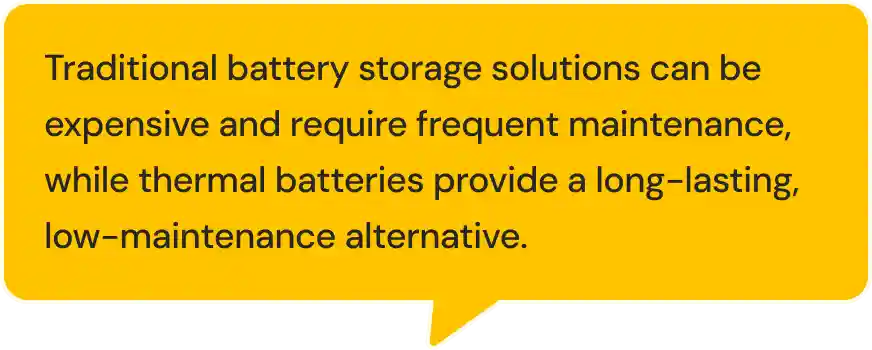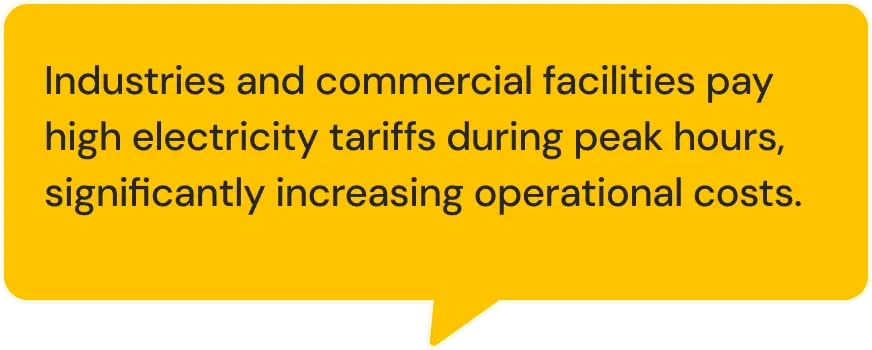
Thermal Battery: Revolutionizing Solar Thermal Solutions
Klymate Technologies LLP is excited to introduce our upcoming Thermal Battery solution—a cutting-edge technology designed to optimize energy consumption by storing thermal energy for use during peak demand periods. This innovative product is ideal for applications where managing heating and cooling efficiently is crucial. Our Thermal Battery solution offers significant advantages over traditional energy storage systems, including peak cutting, valley filling, and enhanced energy cost savings.
What is a Thermal Battery?
A Thermal Battery is a device that stores thermal energy—heat or cold—generated during off-peak hours for use during peak demand periods. Unlike conventional power batteries that store electrical energy, thermal batteries store thermal energy, which can be used to manage heating and cooling needs. This technology is particularly beneficial in reducing the energy demand during peak hours, thereby lowering the associated energy costs.
Key Benefits of Thermal Battery Solutions

Peak Cutting and Valley Filling
Peak Cutting
Absorb sunlight and convert it into direct current (DC).
Valley Filling
During peak demand periods, when energy costs are highest, the Thermal Battery discharges stored energy to meet heating and cooling needs, reducing reliance on the grid.

Cooling During Transit
The Thermal Battery can also be adopted for cooling during transit periods, maintaining the required temperature levels in goods transportation, particularly for temperature-sensitive products.

Scalability
The system can be easily scaled up or down to meet the specific energy needs of your facility, providing flexibility in capacity planning and future expansion.

Standby Energy Storage
In the event of a failure in your primary cooling or heating system, the Thermal Battery acts as a reliable backup, ensuring continuous operation without interruption.

Enhanced Safety
Unlike conventional batteries that carry risks such as overheating or fire hazards, thermal batteries store energy in a stable and safe form, reducing the risk of accidents.

Energy Flexibility
The Thermal Battery can be charged using various energy sources, including renewable energy from solar thermal systems, making it a versatile solution for different applications.

Space Efficiency
The Thermal Battery system is designed to be compact and space-saving, offering more storage capacity in a smaller footprint compared to traditional energy storage systems.

Cost Savings
By shifting energy consumption to non-peak hours, you can significantly reduce the premium charges typically paid for energy during peak periods. This results in substantial cost savings over time.

Increased System Efficiency
The integration of a Thermal Battery into your heating and cooling systems can improve overall system efficiency by optimizing energy use and reducing waste.

Sustainable and Eco-Friendly
By leveraging renewable energy sources and reducing reliance on the grid during peak hours, the Thermal Battery contributes to a significant reduction in carbon emissions, supporting your sustainability goals.

Wide Temperature Range
The Thermal Battery is capable of managing temperatures ranging from -30°C to +120°C, making it suitable for a broad range of applications and industries.
How Does the Thermal Battery Work?

Energy Absorption
During off-peak hours, when energy is cheaper, the Thermal Battery stores excess thermal energy. This energy can come from solar thermal systems, electricity during low-cost periods, or other heat-generating processes.

Energy Storage
The stored thermal energy is held in a phase change material (PCM) or similar medium, which retains heat or cold until it’s needed.

Energy Discharge
During peak demand periods, the Thermal Battery discharges the stored energy to provide heating or cooling, effectively reducing the need to draw expensive energy from the grid.

Continuous Operation
The system operates seamlessly, managing energy use and ensuring that heating and cooling needs are met with minimal reliance on the grid during costly peak periods.
Thermal Battery vs. Conventional Power Battery
| Criteria | Thermal Battery | Conventional Power Battery |
|---|---|---|
| Energy Storage Type | Thermal Energy (Heat/Cold) | Electrical Energy |
| Primary Use | Heating and Cooling Energy Management | Electrical Power Backup |
| Peak Demand Management | Effective for peak cutting and valley filling | Limited, primarily used for power supply |
| Efficiency in HVAC Systems | High, optimized for heating and cooling applications | Lower, not optimized for thermal energy applications |
| Energy Source | Can be charged using solar thermal, off-peak electricity | Charged using electricity only |
| Cost Savings | Significant savings by shifting to off-peak hours | Savings depend on electricity costs and usage |
| Maintenance Requirements | Low, due to fewer mechanical parts | Higher, with regular maintenance needed |
| Environmental Impact | Low, especially when charged using renewable energy | Dependent on the source of electricity |
| Return on Investment (ROI) | Typically less than 5 years | Typically 7 to 10 years |
| Lifespan | Over 25 years | 10 to 15 years |
| Safety | High, with minimal risk of overheating or fire | Moderate, with risks such as overheating |
| Scalability | Easily scalable based on needs | Limited by battery technology |
Applications of Thermal Battery Technology

Industrial Heating and Cooling
Ideal for large-scale facilities that require significant heating or cooling, helping to reduce energy costs and stabilize grid demand.

Food and Beverage Industry
Essential for maintaining the required temperatures in food production, storage, and distribution, ensuring food safety and quality.

Commercial Buildings
Perfect for office buildings, hotels, and other commercial spaces where maintaining comfortable temperatures during peak hours is critical.

Pharmaceutical Industry
Essential for maintaining the required temperatures in food production, storage, and distribution, ensuring food safety and quality.

Cold Chain Logistics
Ensures temperature control during the transportation of perishable goods, maintaining product integrity and reducing spoilage.

Data Centers
Helps in managing the cooling requirements of data centers, reducing energy costs and ensuring optimal performance of IT infrastructure.

Backup for HVAC Systems
Provides reliable backup for HVAC systems, ensuring continuous operation during outages or peak demand periods.

Manufacturing Industries
Supports various manufacturing processes that require precise temperature control, improving product quality and operational efficiency.

Residential Applications
Can be used in homes to manage heating and cooling more efficiently, reducing energy bills and improving comfort.

Agriculture
Useful for controlling temperatures in greenhouses and storage facilities, helping to optimize crop production and reduce spoilage.
The Klymate Advantage: Why Choose Our Thermal Battery Solution?

Innovative Energy Management
Our Thermal Battery technology offers a groundbreaking approach to managing heating and cooling, reducing energy costs, and optimizing energy usage.

Sustainable and Cost-Effective
By leveraging renewable energy and off-peak power, our solution is both environmentally friendly and economically beneficial.

Versatility Across Applications
Whether for industrial, commercial, or residential use, our Thermal Battery can be customized to meet specific energy needs.

Reliable Backup
Acts as a dependable standby during system failures, ensuring uninterrupted service for critical applications.

Proven ROI and Longevity
Our Thermal Batteries offer a return on investment typically less than 5 years, with a lifespan of over 25 years. This makes them a more cost-effective and durable option compared to conventional power batteries, which generally have a 7 to 10-year ROI and a lifespan of 10 to 15 years.

Expert Support and Integration
Klymate Technologies LLP provides comprehensive support, from consultation and system design to installation and maintenance, ensuring your Thermal Battery solution is seamlessly integrated and operates at peak performance.

Conclusion
The Thermal Battery solution by Klymate Technologies LLP is poised to revolutionize how businesses and homes manage their heating and cooling needs. By shifting energy use to non-peak hours and providing reliable backup during peak demand, our Thermal Battery offers a smarter, more sustainable way to reduce energy costs and optimize energy consumption. With a Return on Investment (ROI) typically less than 5 years and a lifespan of over 25 years, our Thermal Battery solution outperforms conventional power batteries in both cost-effectiveness and longevity.
Interested in learning more? Contact us today to explore how our Thermal Battery solution can benefit your operations and help you achieve your energy management goals. Together, let’s pave the way for a more energy-efficient and sustainable future.
| Criteria | Captive Solar Projects | Group Captive Solar Projects | Third-Party Solar Projects |
|---|---|---|---|
| Ownership | Fully owned by a single entity. | Shared among multiple entities. | Owned by a third-party developer. |
| Energy Use | 100% of the energy is used by the owner. | Shared proportionally based on investment. | Purchased by clients through a PPA. |
| Financial Structure | Entirely financed by the owner. | Joint financing by all participants. | No upfront investment by the client; payment based on energy consumption. |
| Minimum Size Requirement | A minimum of 1 MW plant installation is required. | A minimum of 1 MW plant installation is required. | No minimum size requirement, offering greater flexibility. |
| Benefits |
|
|
|
| Drawbacks |
|
|
|
Submit a
Solar Project Enquiry
Our solar experts will guide you in your solar journey
Request A Quote
Recent Blogs
Rooftop Solar Installation in Coimbatore: Powering Homes & Businesses the Smart Way
Coimbatore is one of Tamil Nadu’s fastest-growing cities — with thriving industries, educational institutions, and...
Why Accurate Energy Forecasting Matters for Every Industry in Coimbatore
In today’s fast-paced world, energy is more than just a utility—it’s a strategic business resource. Whether it’s a...
Solar Manufacturing: Powering the Future of Clean Energy with Klymate
The global shift toward renewable energy has placed solar manufacturing at the heart of the clean energy revolution....
FAQs
- Technical
- Commercial
- Technology















